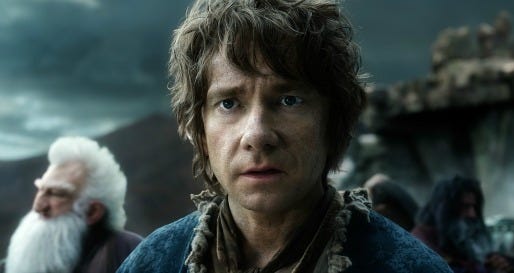The Hobbit: The Battle of the Five Armies

Unlike the triumphant finale of the three “The Lord of the Rings” films, the last movie in “The Hobbit” trilogy feels more like the grateful collapse at the end of an overlong marathon.
With regard to “The Hobbit: The Battle of the Five Armies,” the audience won’t exactly be exclaiming, “Thank goodness that’s over!” But like an overambitious runner who found they’d signed up for a more grueling race than anticipated, the series concludes with quite a bit less enthusiasm and energy than when it started.
As I’ve said in my reviews of the previous two movies: the Middle-Earth of author J.R.R. Tolkien is perhaps my most treasured mythological playground. I grew up adoring these books, dreaming of hobbits, orcs, magical rings and dragons. You could set pretty much any story in this realm and I’d be first in line to buy a ticket.
But director Peter Jackson and his co-screenwriters have so twisted, changed and augmented Tolkien’s straightforward tale that it barely even deserves to have “The Hobbit” in its title. They’ve expanded slender storylines into major themes; turned behind-the-scenes events barely hinted at into full-blown subplots; and, in many cases, just plain ol’ made a bunch of crap up.
It’s still a rousing picture after a slow start; things don’t really get going into the titular battle is joined.
In case you don’t remember, humble hobbit Bilbo Baggins (Martin Freeman) had been plucked by deposed dwarven heir to the throne Thorin (Richard Armitage) and meddling wizard Gandalf (Ian McKellen) to help reclaim the Lonely Mountain taken over long ago by a fearsome dragon.
As this movie opens, the great wyrm Smaug (voice by Benedict Cumberbatch) has been roused from his slumbers and is attacking Lake-town, the tiny fishing village built on docks into the lake next to the mountain. Dutiful bowman Bard (Luke Evans) takes up arms against the dragon and brings him down.
But Thorin, driven mad by a lust for gold from “dragon sickness,” refuses to share any of the great wealth of the mountain with the refugees of Lake-town. And he certainly wants nothing to do with the elven king Thranduil (Lee Pace), who previously kept the company prisoner and now wants his own slice of the pie.
It seems likely to come to a nasty conflict, but meanwhile the Orc armies, led by the terrifying Azog (Manu Bennett), are bearing down on them all. The last half of the movie or so is essentially just a bunch of swordplay.
In the book Bilbo got knocked unconscious at the start of the fighting, and thus everything that transpired went undepicted. Jackson & Co., of course, couldn't do that with a big-budget spectacle, so we get a whole raft of CGI beheadings and splatterings (though curiously bloodless, to keep the PG-13 rating intact).
The best of the "add-on" material involves the effort by Gandalf and other powerful sorcerers — including Galadriel (Cate Blanchett) and Saruman (Christopher Lee) — to force out the evil force that has invaded the fortress of Dol Guldur. As we know, it turns out to be the shade of Sauron, who will go on to cause more trouble down the road. It's a brief but thrilling side excursion.
Other new material is less successful, especially a contrived romance between one of the dwarves and an entirely concocted female elf character (Evangeline Lilly). This results in a love triangle with familiar friend Legolas (Orlando Bloom), plus his daddy issues with the king, and a journey up north that appears to serve no narrative purpose at all.
I was thrilled with what this team of filmmakers did with the "Lord of the Rings," occasionally altering the navigation but keeping the terrain intact. Here, though, they seem like they weren't content with the tale Tolkien spun, and decided to supplant it with their own.
It's still a decent fantasy flick; it's just not "The Hobbit."
3.5 Yaps



